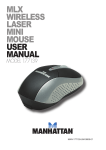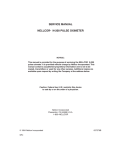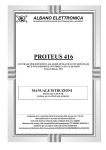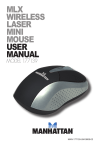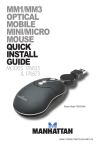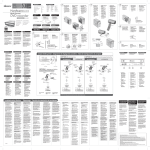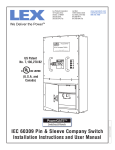Download Manhattan 176811 User manual
Transcript
mmx Wireless Optical Mobile Mini Mouse user manual Model 176811 MAN-176811-UM-0907-03 Thank you for purchasing the MANHATTAN ® MMX Wireless Optical Mobile Mini Mouse, Model 176811. The easy-to-follow instructions in this user manual help make installation of the mouse quick and simple, so you’ll also soon be enjoying the benefits of these features: • 27 MHz technology offers wireless freedom with effective range up to . 1.5 m (5 ft.) • 256 ID codes prevent interference from other RF wireless devices • Auto power management and detachable cable help maintain battery . levels — recharges while in use for uninterrupted operation • On-board storage compartment protects USB receiver from loss and . damage • Compact size, ambidextrous shape and no-slip texture provide a secure and comfortable grip • Low-friction base smoothly glides over work surfaces • Plug and Play installation — Windows compatible • Lifetime Warranty Package Contents • USB Wireless Optical Mouse with Receiver • 2 AAA batteries and retractable cable reel • User manual and carrying bag FCC Statement This equipment has been tested and found to comply with the limits for a class B digital device, pursuant to part 15 of the FCC rules. These limits are designed to provide reasonable protection against harmful interference in a residential installation. This equipment generates, uses and can radiate radio frequency energy and, if not installed and used in accordance with the instructions, may cause harmful interference to radio communications. However, there is no guarantee that interference will not occur in a particular installation. If this equipment does cause harmful interference to radio or television reception — which can be determined by turning the equipment off and then back on — the user 3 is encouraged to try to correct the interference by one or more of the following measures: • Reorient or relocate the receiving antenna. • Increase the separation between the equipment and receiver. • Connect the equipment into an outlet on a circuit different from that to . which the receiver is connected. • Consult your MANHATTAN dealer or an experienced radio/TV technician . for help. installation Built-In Mini Receiver Press the Receiver Out button and the mini receiver will pop out of the back of the mouse. Re-insert the receiver and the mouse/transmitter power will Battery automatically be turned off. compartment cover Receiver Out button Receiver access Batteries Press down on the battery compartment cover just behind the Receiver Out button (as shown above) and slide the cover back to access the compartment. Insert the two included AAA batteries, matching the polarity indicators on the inside of the compartment. Replace the cover, sliding it forward till it clicks in place. 4 operation ID Setup for Wireless Operation With the mouse positioned near the receiver, ID use a hard, narrow object (such as a pin or connect a straightened paper clip) to press both ID IDbuttons buttons: first on the receiver; then, within 10 seconds, on the underside of the mouse. Hold each button in for a full second. The receiver light will flash rapidly for a few seconds, then remain lit, indicating that the connection between the receiver and the mouse has been made and the mouse is ready for wireless operation. Wired Operation Where the use of wireless devices is restricted; or when the mouse is low on power — the mouse can be operated as a wired device. With the retractable cable connected to the front of the mouse, connect the other end to the computer. If only a PS/2 port is available, an adapter can be used. Remember to place the receiver back in the mouse so you don’t lose it. Low Battery Charging Battery LEDLow batte While using the mouse, if the red Low Battery LED flashes, re-charge or change the batteries. To re-charge, connect the mouse Charge connecto to the computer with a USB cable. The mouse can be used while the batteries charge; a full Charge connector charge requires 8-10 hours. To stop charging, unplug the cable. NOTE: The actual charging time depends on the degree of the discharge. 5 Operating Tips • Operate the mouse within 1.5 m (5 ft.) of the receiver. • Place the mouse on a white or light-colored surface for optimal performance. Remove the batteries if the mouse will not be used for an extended period of time or if you transport the device outdoors. • The mouse automatically enters a sleep mode after a period of inactivity to save power. Press any key or scroll to wake it. • To disconnect power to the mouse, press and hold the ID button on the underside of the mouse for 3 seconds. To restore power to the mouse, . press the ID button again. • If the Low Battery LED on the receiver flashes when the mouse is moved, . change or re-charge the batteries immediately. • The optical mouse will not work freely on a smooth desk, glass or any reflective surface or 3D mouse pad. • Remember to store the receiver in the mouse when it’s not being used. specifications Standards and Certifications • USB 1.1, FCC, CE, WEEE Dimensions • Mouse: optical, 800 dpi; 9.5 x 5.4 x 3.5 cm (3.75 x 2.125 x 1.4 in.); General 76.5 g (2.7 oz.) • USB 1.1 receiver • USB receiver: 27 MHz (256 IDs); • RF 27 MHz with 256 IDs 5.5 x 1.5 x 1 cm (2.2 x 0.6 x 0.4 • Recharge time: 8-10 hours to in.); 5.7 g (0.2 oz.) fully charge • USB retractable cable: A-type • Mouse: optical, 800 dpi resolution male to mini-B-type male, 76 cm • Automatic power save/power off (30 in.) mode • LED indicator: Activity Environmental • Controls: right and left mouse • Operational temperature: 0 – 45°C with scroll wheel • Storage temperature: -40 – 45°C • Material: ABS plastic • Working humidity: <85% • Compatible with Windows 2000/ • Electrical: 5 V <30 mA XP/Vista 6 MANHATTAN offers a complete line of PC Components, Peripherals, Cables and Accessories. Ask your local computer dealer for more information or visit us online at ® www.manhattan-products.com Copyright © MANHATTAN All products mentioned are trademarks or registered trademarks of their respective owners.









